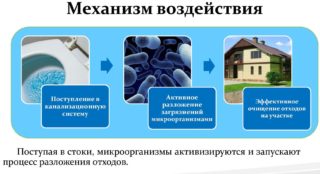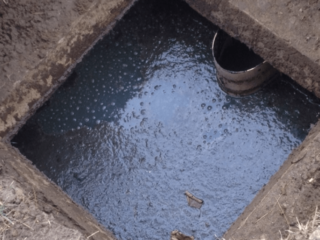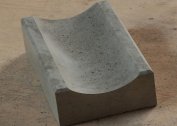Failure of the sewerage system can poison life in a private house in the literal and figurative meaning. Information on the causes of siltation of the cesspool and cleaning methods will help to avoid troubles and minimize the consequences in the event of an emergency.
Work and construction of a cesspool
A pit is organized in each private house for the accumulation of household waste in a specific location on the site. When building a house, they calculate the optimal tank size in accordance with sanitary and construction standards. They are placed so as to provide a convenient access for large-sized special equipment. The volume of wastewater daily entering the sump is determined by the number of people living and the amount of water-consuming equipment. The design of the sewage pit depends on the requests of the owner.
A simple street toilet and a complex sewage system work on the same principle, despite the fact that a high-tech septic tank in appearance is very different from a sewage pit. By design type there are:
- sealed - domestic wastewater is isolated from penetration into the environment in large-capacity tanks;
- open - a tank without a bottom is installed on the filter layer through which purified industrial water seeps into the ground;
- combined - a system of three or more tanks, where sequential wastewater treatment takes place, with the former being sealed and the latter open.
Regardless of the useful volume or device, cesspools are regularly filled with water, organic waste and need to remove excess viscous liquid. If this is not done, organic residues suspended in domestic wastes and inorganic particles gradually settle to the bottom of the tank. Viscous sludge forms, gradually condenses, turning into a solid precipitate. Sludge deposits in the pit deteriorate, and sometimes make it impossible to use the tank as a storage device for household waste.
The combination of mechanical, chemical, biological cleaning methods allows you to maintain the sump in working condition.
Causes of siltation of a septic tank
If the domestic sewage tank overflows too often, you need to figure out why this happens. Possible options:
- In a country house or in the country, the number of permanent residents has increased. A pit designed for a smaller volume of effluents does not cope with its work. If the guests live temporarily, for some time it will be necessary to pump out the technical water more often on their own or to call the sewage system for this. If tenants have settled permanently, it is necessary to increase the volume of the drive.
- Silting occurred, less liquid was placed in the pit. A layer of sewage accumulated at the bottom reduced the useful volume of the tank. To restore functionality, you need to get rid of the sludge in the cesspool.
- Fat deposits formed. Water-insoluble fat particles compact the loose sludge sediment, worsen its filtering properties. Water stagnates.
- The process of decaying waste slowed down. Bacteria do not have time to process an increased flow of domestic water, or the number of bioactive microorganisms that decompose waste has decreased. This can occur in the cold season or in a chemically aggressive environment. Microorganisms die with excessive use of chlorine-based detergents or synthetic detergents.Untreated waste settles to the bottom, forming a layer of solid sludge.
Silting can also be caused by external causes: a violation of the tightness of the sump, due to which groundwater enters the tank; improper operation of the drainage system.
Signs of siltation of the sump
When the first signs of deterioration of the working properties of the pit appear, measures must be taken to identify and eliminate problems. The following signals should be noted:
- The outflow of domestic wastes is very slow. Less liquid was placed in the pit.
- It is necessary to pump out contaminated water with a drainage pump for sewerage or to resort to the services of sewage cleaners not once every two months as before, but every three to four weeks.
- The sludge mass emerging on the surface of the water is visible through the inspection hatch.
- Traces of grease are visible on the surface of drains or on the walls of the tank.
- Unpleasant odor spreads over the area even with the hatch closed.
- The tank is filled with solid sediment.
Any of these signs is a warning of future problems. To restore the functionality of the cesspool helps timely cleaning.
Effective Ways to Combat
The siltation of the sump can be solved in several ways:
- manually remove sludge from the cesspool using a bucket on a rope;
- use mechanical devices: a powerful sewage pump or a sewer sludge pump equipped with a vacuum pump and a hydraulic gun for breaking up solid sediments.
For easier removal, the sludge must first be softened: add clean water to the pit for a day or more or apply biological preparations.
The sewage drainage pump is equipped with a grinder. It effectively grinds the solids of the sedimentary layer, turning them into a semi-liquid mass, easily removed from the pit.
An attempt to clean the cesspool from the sludge using household chemical products, especially chlorine-containing ones, can destroy bacteria that decompose organic household waste into simple components. This will reduce the effectiveness of the sump for a long time. Chemical methods for cleaning tanks are used in the cold season, when biological products cease to act for natural reasons.
Chemicals are effective, but not cheap. Previously, ammonium salts and formaldehyde were used to clean containers from sludge. However, these compounds were found to be extremely toxic. Now sodium nitrate is used, thanks to which bottom sludge can be used as fertilizer.
Preventative measures
Simple procedures will help to avoid siltation of the pit. It is important to conduct them regularly:
- pump out liquid household waste without waiting for the tank to overflow or stagnate;
- knock down solid deposits from the walls or bottom of the tank using a jet of water under pressure or a stiff brush once every two months;
- update microorganisms in the tank by emptying a pack of biological product at least 1 time per month.
Protecting the cesspool from freezing by creating a heat-shielding layer or by deepening the reservoir below the level of freezing of the soil is an effective prevention of siltation, helping to maintain the bacterial performance at a high level even in the cold season.






